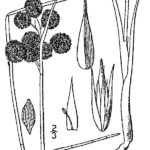Juncus torreyi
USDA, NRCS. 2018. The PLANTS Database (http://plants.usda.gov, 28 March 2018). National Plant Data Team, Greensboro, NC 27401-4901 USA.
Illustration: USDA-NRCS PLANTS Database / Britton, N.L., and A. Brown. 1913. An illustrated flora of the northern United States, Canada and the British Possessions. 3 vols. Charles Scribner’s Sons, New York. Vol. 1: 478.
What is Torrey’s Rush?
Physical Characteristics
Leaves:
- Wide near base
- Small near tip
- Growing upward
Flowers:
- Smaller than the flower stalk
- 25-50 flowers per stalk
- Closely clustered
- Brownish petals
- Petals shorter than sepals
- 6 anthers
Flower Stalk:
- 0.78-4 inches long
- 5-10 heads
Sepals:
- Sword-shaped
- 0.16-0.2 inches long
- brownish in color
Fruit:
- Dry seed pod
- Brownish
- 3-sided
Stem:
- Long rhizomes
- Flowering
- Hollow
- Upright
- 1-3.25 feet long
- 0.08-0.16 inches thick
Where Does it Grow?
Torrey’s rush can be found along ponds, streams, lakes, wet meadows, ditches and seepage areas.
Pros and Cons of Torrey’s Rush
Submerged portions of all aquatic plants provide habitats for many micro and macro invertebrates. These invertebrates in turn are used as food by fish and other wildlife species (e.g. amphibians, reptiles, ducks, etc.). After aquatic plants die, their decomposition by bacteria and fungi provides food (called “detritus”) for many aquatic invertebrates.


